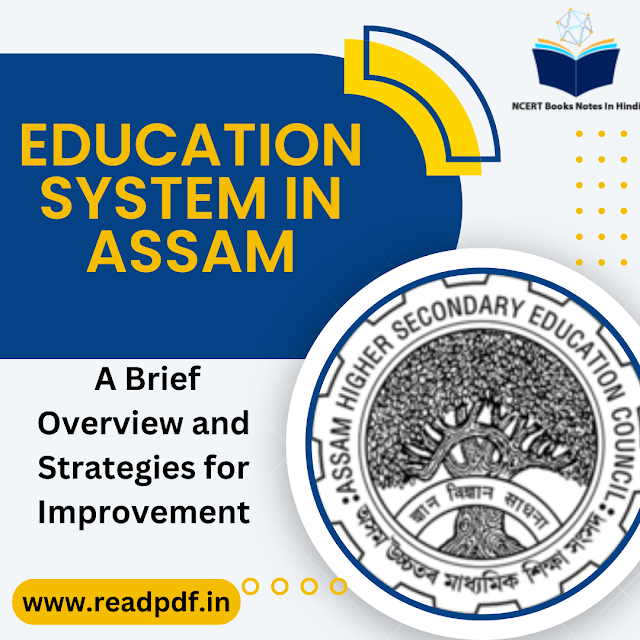Education plays a crucial role in the development of individuals and societies. In Assam, a state located in northeastern India, the education system has undergone significant changes over the years. This article aims to provide a comprehensive understanding of the education system in Assam, highlight the recent reforms, and suggest strategies to further improve the system.
Overview of the Education System in Assam
Historical Perspective
The education system in Assam has a rich history dating back to ancient times. Traditionally, education in Assam was imparted through Gurukuls and Pathshalas, where students received instruction in various subjects, including literature, philosophy, and art. However, with the advent of British colonization, a more formalized education system was introduced, influenced by Western educational practices.
Current State of Education
Today, Assam's education system comprises various levels, including primary, secondary, and higher education. The state follows a 10+2 system, with 10 years of schooling followed by two years of higher secondary education. Assam Higher Secondary Education Council (AHSEC) oversees the higher secondary examinations in the state, while several universities and colleges provide tertiary education.
Recent Reforms in Assam's Education System
Introduction of New Education Policy
Assam has recently adopted the New Education Policy (NEP) to revamp its education system. The NEP emphasizes a holistic approach to education, focusing on the overall development of students rather than just academic achievements. It promotes experiential learning, critical thinking, and creativity, enabling students to become well-rounded individuals.
Emphasis on Holistic Development
The new education system in Assam places significant emphasis on holistic development. It encourages students to engage in co-curricular activities such as sports, arts, and cultural events. Students can develop their physical, emotional, and social skills by fostering a well-rounded education, leading to a more comprehensive educational experience.
Enhancing Digital Infrastructure
To keep pace with the digital era, Assam's education system is making efforts to enhance digital infrastructure. This includes providing schools and colleges with access to technology, internet connectivity, and educational resources. By integrating technology into classrooms, students can benefit from online learning platforms, virtual libraries, and interactive educational tools.
Challenges Faced by the Education System in Assam
Inadequate Infrastructure
One of the major challenges faced by the education system in Assam is inadequate infrastructure. Many schools lack basic facilities such as classrooms, libraries, laboratories, and sanitation facilities. Addressing this issue is crucial to creating a conducive learning environment for students and teachers.
High Dropout Rates
Assam experiences high dropout rates, particularly in remote and economically disadvantaged areas. Factors such as poverty, lack of transportation, and early marriage contribute to students discontinuing their education. Implementing measures to improve access to education and addressing the underlying socio-economic issues can help reduce dropout rates.
Disparity in Rural and Urban Education
There is a significant disparity in the quality of education between rural and urban areas in Assam. Rural schools often need more qualified teachers and limited access to educational opportunities. Bridging this gap requires targeted interventions, including improving infrastructure, recruiting trained teachers, and providing equal opportunities for students in all regions.
Strategies to Improve the Education System in Assam
Quality Teacher Training Programs
Investing in comprehensive teacher training programs is essential for enhancing the education system in Assam. These programs should focus on equipping teachers with the necessary pedagogical skills, subject knowledge, and classroom management techniques. Continuous professional development opportunities should be provided to ensure teachers stay updated with the latest teaching methodologies.
Strengthening Vocational Education
Promoting vocational education can contribute to the overall development of students and address the skill gap in the job market. By offering practical and career-oriented courses, students can acquire skills that make them employable. Collaborating with industries and providing apprenticeships can further enhance vocational education in Assam.
Promoting Inclusivity and Access
Efforts should be made to ensure inclusivity and access to education for all sections of society. Special provisions should be made for marginalized communities, children with disabilities, and girls. Scholarships, incentives, and awareness campaigns can encourage these groups to pursue education and break down barriers to access.
Conclusion
The education system in Assam has witnessed positive changes in recent years, with the introduction of the New Education Policy and emphasis on holistic development and digital infrastructure. However, challenges such as inadequate infrastructure, high dropout rates, and disparity between rural and urban education persist. By implementing strategies like quality teacher training, strengthening vocational education, and promoting inclusivity and access, Assam can strive towards an improved education system that nurtures the potential of its youth.
Education System in Assam FAQs
How has the education system in Assam evolved over time?
The education system in Assam has evolved from traditional Gurukuls to a more formalized system influenced by Western practices. It has undergone significant changes, with recent reforms focusing on holistic development and digital integration.
What is the New Education Policy (NEP), and how does it impact Assam?
The New Education Policy is a comprehensive framework for transforming the education system in India. Assam has adopted the NEP, which emphasizes holistic education, experiential learning, and the integration of technology in classrooms.
What are the major challenges faced by the education system in Assam?
Some of the major challenges include inadequate infrastructure, high dropout rates, and the disparity between rural and urban education.
How can vocational education contribute to the improvement of the education system in Assam?
Vocational education equips students with practical skills that make them employable. By strengthening vocational education, Assam can bridge the skill gap and provide students with diverse career opportunities.
What measures can be taken to promote inclusivity and access in Assam's education system?
Measures such as scholarships, incentives, and awareness campaigns can promote inclusivity and access to education for marginalized communities, children with disabilities, and girls, ensuring equal opportunities for all.
What is the current education system in Assam?
The current education system in Assam follows a combination of traditional classroom teaching, digital learning initiatives, and vocational training programs to cater to the diverse needs of students.
What is current education system?
The current education system refers to the prevailing methods and structures employed in schools and institutions to facilitate learning and knowledge acquisition.
What is the rank of Assam in education?
Assam's rank in education is variable and subject to change over time. It is advisable to refer to the latest educational rankings and reports for accurate information.
Which district of Assam is highest educated?
Kamrup Metropolitan district is considered to be the highest educated district in Assam, with a high literacy rate and access to educational institutions.


